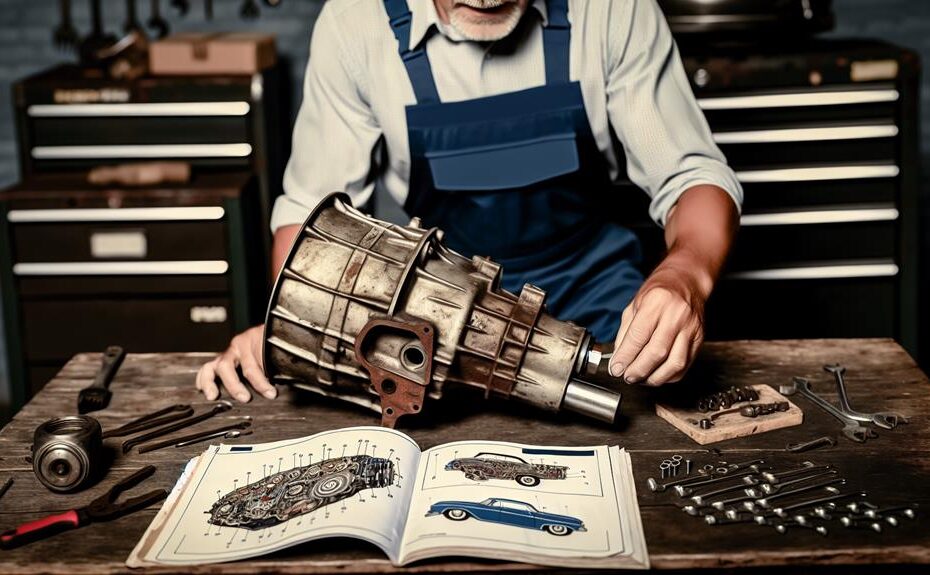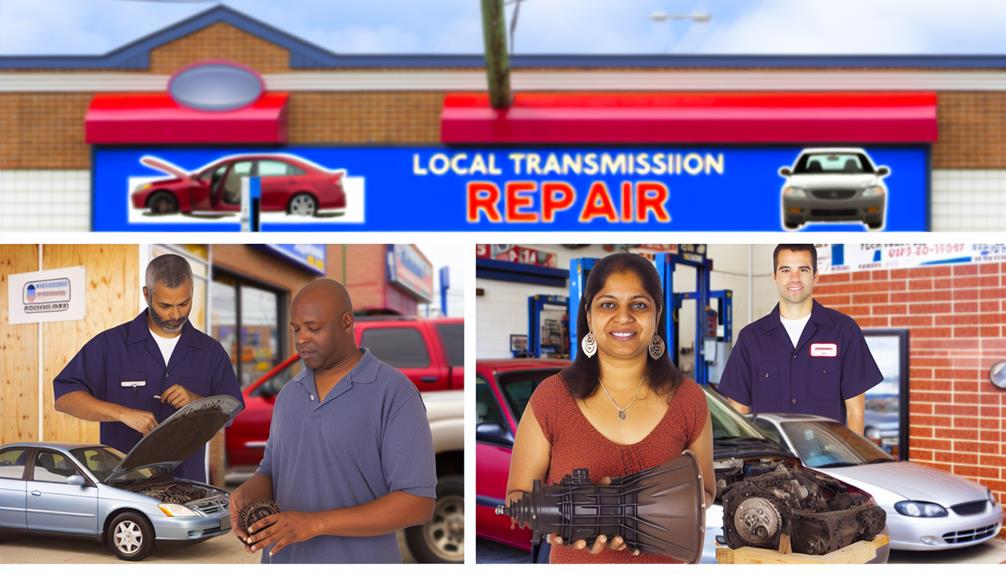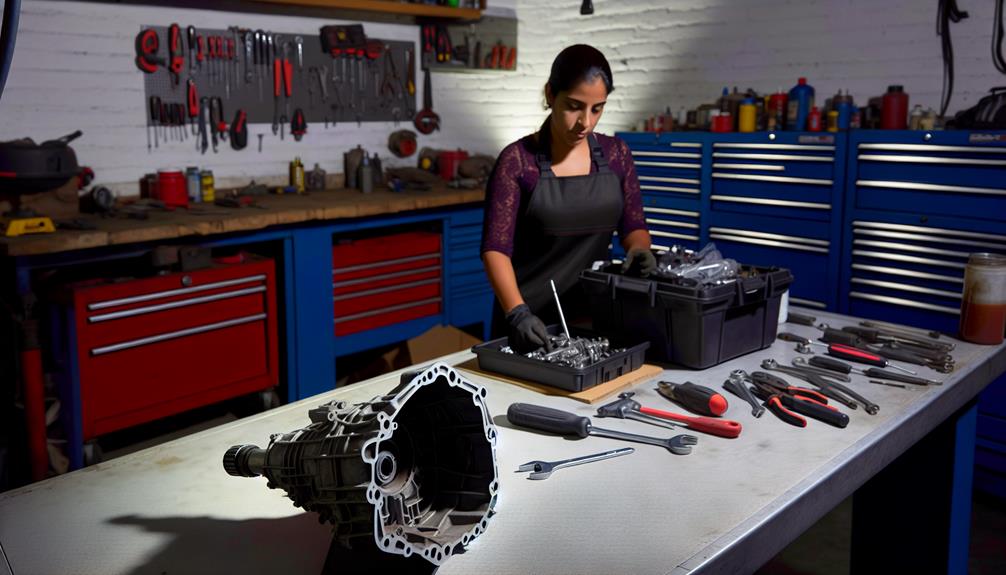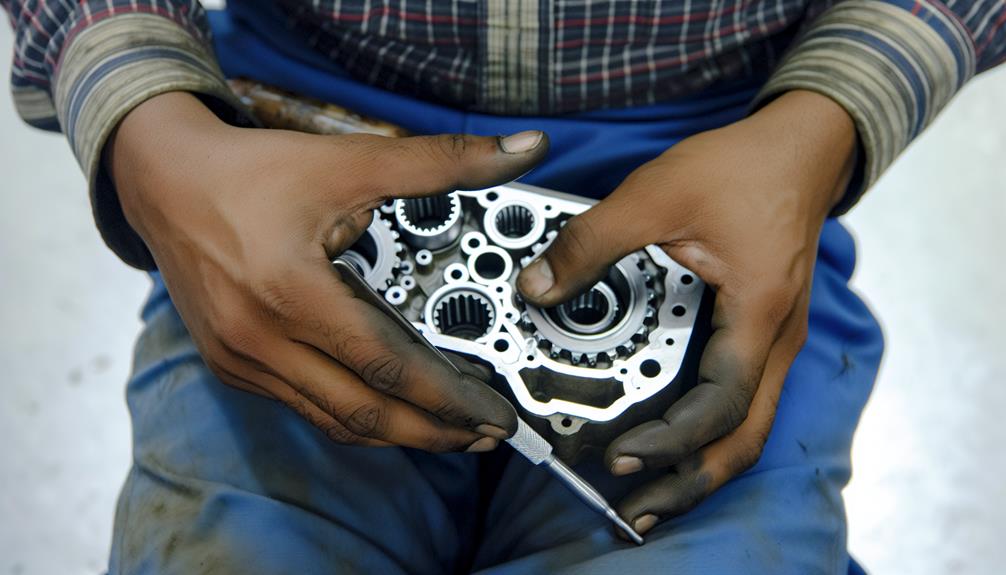Did you know that restoring vintage vehicle transmissions can be a challenging yet rewarding endeavor? Whether you're a seasoned mechanic or a passionate vintage car enthusiast, the process of bringing an old transmission back to life requires careful attention to detail and a comprehensive understanding of the inner workings of these mechanical marvels.
From identifying common transmission problems to acquiring the necessary tools and equipment, this comprehensive guide will take you step-by-step through the restoration process, providing you with invaluable tips and techniques along the way.
So, if you're ready to embark on a journey that will revive the heart and soul of your vintage vehicle, let's dive into the world of vintage transmission restoration together.
Key Takeaways
- Vintage vehicle transmissions can be classified into manual, automatic, semi-automatic, and overdrive transmissions, allowing for different driving experiences.
- Common transmission problems in vintage vehicles include worn clutches, leaking seals and gaskets, and synchronizer issues, which can affect the overall performance.
- Tools and equipment such as a transmission jack, torque wrench, and transmission fluid exchanger are essential for proper transmission repair and maintenance.
- When restoring a vintage transmission, it is important to thoroughly clean the transmission, test its functionality, inspect for wear, and perform reassembly and adjustment as needed.
Types of Vintage Vehicle Transmissions
There are several types of vintage vehicle transmissions that were commonly used during the mid-20th century. Transmission identification is crucial when restoring or upgrading vintage vehicle transmissions.
The most common type of transmission during this era was the manual transmission. These transmissions required the driver to manually shift gears using a clutch pedal and gear stick.
Another popular option was the automatic transmission, which offered the convenience of shifting gears automatically without the need for manual input. It utilized fluid pressure and a torque converter to engage and disengage gears.
Additionally, there were also semi-automatic transmissions that combined the best of both worlds. They allowed the driver to shift gears manually without a clutch pedal, making them easier to operate.
Upgrading vintage vehicle transmissions can enhance performance and drivability. Many enthusiasts opt for modern upgrades such as overdrive transmissions, which provide better fuel efficiency and increased top-end speed.
Upgrading to a more robust transmission can also handle higher horsepower and torque, ensuring a smoother and more reliable driving experience.
Common Transmission Problems in Vintage Vehicles
If you're restoring a vintage vehicle transmission, it's important to be aware of the common problems that can arise with these older systems. Diagnosing transmission issues in vintage vehicles can be a complex task, but understanding the common transmission problems can help you identify and address them effectively. Here are three common transmission problems you may encounter during your restoration project:
- Worn Clutch: Over time, the clutch in a vintage vehicle transmission can wear out due to constant friction and heat. Symptoms of a worn clutch include slipping gears, difficulty shifting, and a burning smell. To repair this issue, you'll need to replace the clutch disc, pressure plate, and release bearing.
- Leaking Seals and Gaskets: Vintage vehicle transmissions often suffer from leaking seals and gaskets due to age and deterioration. These leaks can cause a loss of fluid, leading to inadequate lubrication and potential damage to the transmission. Repairing this issue requires replacing the faulty seals and gaskets.
- Synchronizer Problems: Synchronizers are responsible for smooth gear shifting in a manual transmission. In vintage vehicles, these components can wear out, causing grinding noises and difficulty shifting gears. Replacing the worn-out synchronizers can resolve this problem.
Tools and Equipment for Transmission Repair

When repairing vintage vehicle transmissions, having the right tools and equipment is crucial for a successful restoration project. To effectively repair and restore a transmission, you'll need a set of transmission repair tools and essential equipment specifically designed for vintage vehicle restoration.
One of the most important transmission repair tools is a transmission jack. This specialized tool allows you to safely and efficiently remove and install the transmission. It provides stability and support, making the process much easier and reducing the risk of damage.
Another essential tool is a torque wrench. This tool ensures that the bolts and fasteners are tightened to the correct specifications, preventing over-tightening or under-tightening, which can lead to transmission issues.
A transmission fluid exchanger is also a must-have piece of equipment. This device helps flush out the old transmission fluid and replace it with new fluid, ensuring optimal performance and longevity of the transmission.
Other important tools include a transmission pressure gauge, which allows you to measure the pressure within the transmission, and a transmission cooler line disconnect tool, which makes it easier to disconnect and reconnect the cooler lines during transmission repairs.
Having these transmission repair tools and essential equipment will greatly facilitate the restoration process, making it more efficient and successful. So, make sure you invest in high-quality tools and equipment to ensure a smooth transmission repair and restoration experience.
Step-by-Step Guide to Restoring a Vintage Transmission
To successfully restore a vintage transmission, it's essential to have a thorough understanding of the transmission repair process and the necessary tools and equipment. Follow this step-by-step guide to ensure a successful restoration:
- Cleaning process: Before beginning any repairs, it's crucial to thoroughly clean the vintage transmission. Start by removing any dirt, grime, or debris from the external components. Next, disassemble the transmission and clean each individual part using a degreaser and a brush. Take extra care when cleaning delicate components to avoid damage.
- Testing techniques: Once the vintage transmission is clean, it's time to test its functionality. Begin by inspecting each part for signs of wear or damage. Use specialized tools, such as dial indicators and micrometers, to measure critical dimensions and tolerances. Conduct a visual inspection of the gears, bearings, and seals for any signs of wear. Test the clutch engagement, shifting smoothness, and synchronizer operation. Additionally, perform a pressure test to ensure proper hydraulic function.
- Reassembly and adjustment: After completing the cleaning and testing processes, reassemble the vintage transmission using new gaskets, seals, and bearings as needed. Make sure to follow the manufacturer's specifications for torque settings and adjustment procedures. Take the time to properly adjust the clutch, linkage, and shift forks to ensure optimal performance.
Tips for Maintaining a Restored Vintage Vehicle Transmission
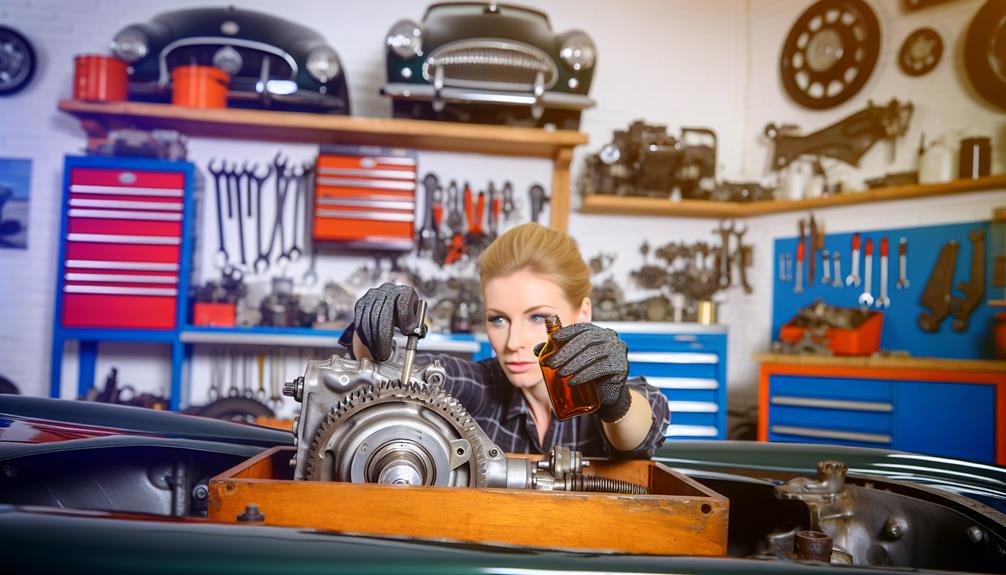
For optimal performance and longevity of your restored vintage vehicle transmission, it's important to follow these tips for maintenance.
First and foremost, establish a regular maintenance schedule for your transmission. This will ensure that it's inspected and serviced at appropriate intervals. A recommended schedule is to have the transmission checked every 30,000 miles or two years, whichever comes first. This will help identify any potential issues before they become major problems.
When it comes to fluid selection, it's crucial to use the correct type and grade of transmission fluid. Consult your vehicle's manual or a trusted mechanic to determine the right fluid for your specific transmission. Using the wrong fluid can lead to poor performance and even damage to the transmission.
Regularly check the transmission fluid level and condition. The fluid should be at the appropriate level and free from any debris or discoloration. If the fluid appears dirty or smells burnt, it may be an indication of a problem and should be addressed immediately.
In addition to regular maintenance, be mindful of your driving habits. Avoid aggressive driving, excessive towing, and overloading your vehicle, as these can put unnecessary strain on the transmission.
Frequently Asked Questions
How Much Does It Cost to Restore a Vintage Vehicle Transmission?
Restoring a vintage vehicle transmission can be costly. Factors like the extent of damage, availability of parts, and labor fees contribute to the total expenses. Average restoration costs range from a few hundred to several thousand dollars.
Are There Any Specific Vintage Vehicle Models That Are More Difficult to Restore Transmissions For?
When it comes to restoring vintage vehicle transmissions, some models can pose more challenges than others. Certain vintage vehicle models require specialized knowledge and parts, making the restoration process more difficult and time-consuming.
Can I Use Modern Transmission Parts in a Vintage Vehicle Transmission Restoration?
You can definitely use modern transmission parts in a vintage vehicle transmission restoration. While there may be some compatibility issues, aftermarket parts can be a cost-effective way to upgrade and improve your vehicle's performance.
What Are Some Signs That Indicate the Need for a Transmission Restoration in a Vintage Vehicle?
If your vintage vehicle is experiencing common transmission problems like slipping gears, grinding noises, or fluid leaks, it might be time for a transmission restoration. To ensure a successful restoration, choose a knowledgeable expert.
Are There Any Safety Precautions I Should Take When Working on a Vintage Vehicle Transmission Restoration?
When working on a vintage vehicle transmission restoration, safety precautions are vital. Make sure to wear protective gear like gloves and goggles. Use the necessary tools, such as a jack and wrench, to ensure a safe and successful restoration.
Conclusion
Congratulations! You have now become a transmission restoration expert! With this comprehensive guide, you have gained the knowledge and skills to tackle any vintage vehicle transmission problem.
Armed with the right tools and equipment, you can confidently restore and maintain these mechanical wonders. So, go ahead and embark on your journey to revive these nostalgic beauties, knowing that you have the expertise to make them run smoothly once again.
Happy restoring!
- How Much Does a Ford 9N Tractor Weigh - May 20, 2024
- How Many of My Exact Car were Made: Uncovering the Rarity - May 20, 2024
- How to Find Out What Someone Drives: Discover the Truth - May 20, 2024
